Input parameters of the AWS DeepRacer reward function
The AWS DeepRacer reward function takes a dictionary object as the input.
def reward_function(params) : reward = ... return float(reward)
The params dictionary object contains the following key-value
pairs:
{ "all_wheels_on_track": Boolean, # flag to indicate if the agent is on the track "x": float, # agent's x-coordinate in meters "y": float, # agent's y-coordinate in meters "closest_objects": [int, int], # zero-based indices of the two closest objects to the agent's current position of (x, y). "closest_waypoints": [int, int], # indices of the two nearest waypoints. "distance_from_center": float, # distance in meters from the track center "is_crashed": Boolean, # Boolean flag to indicate whether the agent has crashed. "is_left_of_center": Boolean, # Flag to indicate if the agent is on the left side to the track center or not. "is_offtrack": Boolean, # Boolean flag to indicate whether the agent has gone off track. "is_reversed": Boolean, # flag to indicate if the agent is driving clockwise (True) or counter clockwise (False). "heading": float, # agent's yaw in degrees "objects_distance": [float, ], # list of the objects' distances in meters between 0 and track_length in relation to the starting line. "objects_heading": [float, ], # list of the objects' headings in degrees between -180 and 180. "objects_left_of_center": [Boolean, ], # list of Boolean flags indicating whether elements' objects are left of the center (True) or not (False). "objects_location": [(float, float),], # list of object locations [(x,y), ...]. "objects_speed": [float, ], # list of the objects' speeds in meters per second. "progress": float, # percentage of track completed "speed": float, # agent's speed in meters per second (m/s) "steering_angle": float, # agent's steering angle in degrees "steps": int, # number steps completed "track_length": float, # track length in meters. "track_width": float, # width of the track "waypoints": [(float, float), ] # list of (x,y) as milestones along the track center }
A more detailed technical reference of the input parameters is as follows.
all_wheels_on_track
Type: Boolean
Range:
(True:False)
A Boolean flag to indicate whether the agent is on-track or
off-track. It's off-track (False) if any of its wheels are outside of
the track borders. It's on-track (True) if all of the wheels are inside
the two track borders. The following illustration shows that the agent is on-track.
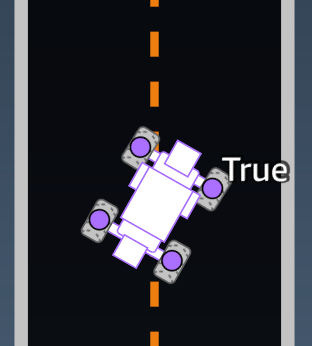
The following illustration shows that the agent is off-track.

Example:
A reward function using the
all_wheels_on_track parameter
def reward_function(params): ############################################################################# ''' Example of using all_wheels_on_track and speed ''' # Read input variables all_wheels_on_track = params['all_wheels_on_track'] speed = params['speed'] # Set the speed threshold based your action space SPEED_THRESHOLD = 1.0 if not all_wheels_on_track: # Penalize if the car goes off track reward = 1e-3 elif speed < SPEED_THRESHOLD: # Penalize if the car goes too slow reward = 0.5 else: # High reward if the car stays on track and goes fast reward = 1.0 return float(reward)
closest_waypoints
Type: [int, int]
Range: [(0:Max-1),(1:Max-1)]
The zero-based indices of the two neighboring waypoints closest to
the agent's current position of (x, y). The distance is measured by the
Euclidean distance from the center of the agent. The first element refers to the
closest waypoint behind the agent and the second element refers the closest waypoint
in front of the agent. Max is the length of the waypoints list. In the
illustration shown in waypoints, the
closest_waypoints would be [16, 17].
Example: A reward function using the
closest_waypoints parameter.
The following example reward function demonstrates how to use
waypoints and closest_waypoints as well as
heading to calculate immediate rewards.
AWS DeepRacer supports the following libraries: math, random, NumPy, SciPy, and Shapely. To use one, add an import statement, import , above your function definition, supported librarydef function_name(parameters).
# Place import statement outside of function (supported libraries: math, random, numpy, scipy, and shapely) # Example imports of available libraries # # import math # import random # import numpy # import scipy # import shapely import math def reward_function(params): ############################################################################### ''' Example of using waypoints and heading to make the car point in the right direction ''' # Read input variables waypoints = params['waypoints'] closest_waypoints = params['closest_waypoints'] heading = params['heading'] # Initialize the reward with typical value reward = 1.0 # Calculate the direction of the center line based on the closest waypoints next_point = waypoints[closest_waypoints[1]] prev_point = waypoints[closest_waypoints[0]] # Calculate the direction in radius, arctan2(dy, dx), the result is (-pi, pi) in radians track_direction = math.atan2(next_point[1] - prev_point[1], next_point[0] - prev_point[0]) # Convert to degree track_direction = math.degrees(track_direction) # Calculate the difference between the track direction and the heading direction of the car direction_diff = abs(track_direction - heading) if direction_diff > 180: direction_diff = 360 - direction_diff # Penalize the reward if the difference is too large DIRECTION_THRESHOLD = 10.0 if direction_diff > DIRECTION_THRESHOLD: reward *= 0.5 return float(reward)
closest_objects
Type: [int, int]
Range: [(0:len(objects_location)-1),
(0:len(objects_location)-1)]
The zero-based indices of the two closest objects to the agent's current position of (x, y). The first index refers to the closest object behind the agent, and the second index refers to the closest object in front of the agent. If there is only one object, both indices are 0.
distance_from_center
Type: float
Range: 0:~track_width/2
Displacement, in meters, between the agent center and the track center. The
observable maximum displacement occurs when any of the agent's wheels are outside a
track border and, depending on the width of the track border, can be slightly
smaller or larger than half the track_width.
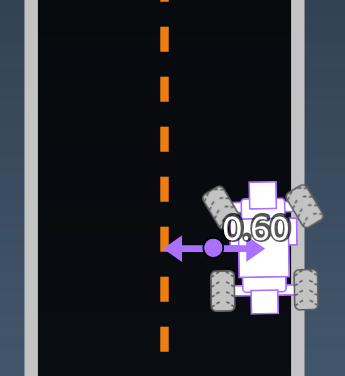
Example:
A reward function using the
distance_from_center parameter
def reward_function(params): ################################################################################# ''' Example of using distance from the center ''' # Read input variable track_width = params['track_width'] distance_from_center = params['distance_from_center'] # Penalize if the car is too far away from the center marker_1 = 0.1 * track_width marker_2 = 0.5 * track_width if distance_from_center <= marker_1: reward = 1.0 elif distance_from_center <= marker_2: reward = 0.5 else: reward = 1e-3 # likely crashed/ close to off track return float(reward)
heading
Type: float
Range: -180:+180
Heading direction, in degrees, of the agent with respect to the x-axis of the coordinate system.
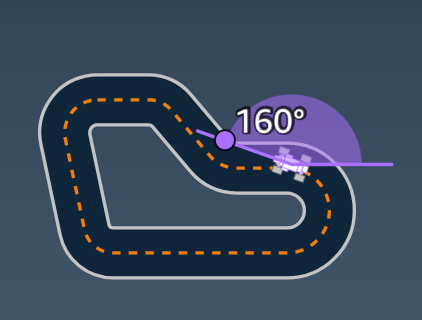
Example:
A reward function using the heading
parameter
For more information, see closest_waypoints.
is_crashed
Type: Boolean
Range: (True:False)
A Boolean flag to indicate whether the agent has crashed into another object
(True) or not (False) as a termination status.
is_left_of_center
Type: Boolean
Range: [True : False]
A Boolean flag to indicate if the agent is on the left side to the
track center (True) or on the right side (False).
is_offtrack
Type: Boolean
Range: (True:False)
A Boolean flag to indicate whether the agent has off track (True) or not (False) as a termination status.
is_reversed
Type: Boolean
Range:
[True:False]
A Boolean flag to indicate if the agent is driving on clock-wise (True) or counter clock-wise (False).
It's used when you enable direction change for each episode.
objects_distance
Type: [float, … ]
Range: [(0:track_length), … ]
A list of the distances between objects in the environment in relation to the starting line. The ith element measures the distance in meters between the ith object and the starting line along the track center line.
Note
abs | (var1) - (var2)| = how close the car is to an object, WHEN var1 = ["objects_distance"][index] and var2 = params["progress"]*params["track_length"]
To get an index of the closest object in front of the vehicle and the closest object behind the vehicle, use the "closest_objects" parameter.
objects_heading
Type: [float, … ]
Range: [(-180:180), … ]
List of the headings of objects in degrees. The ith element measures the heading of the ith object. For stationary objects, their headings are 0. For a bot vehicle, the corresponding element's value is the vehicle's heading angle.
objects_left_of_center
Type: [Boolean, … ]
Range: [True|False, … ]
List of Boolean flags. The ith element value indicates whether the ith object is to the left (True) or right (False) side of the track center.
objects_location
Type: [(x,y), … ]
Range:
[(0:N,0:N), … ]
List of all object locations, each location is a tuple of (x, y).
The size of the list equals the number of objects on the track. Note the object could be the stationary obstacles, moving bot vehicles.
objects_speed
Type: [float, … ]
Range: [(0:12.0), … ]
List of speeds (meters per second) for the objects on the track. For stationary objects, their speeds are 0. For a bot vehicle, the value is the speed you set in training.
progress
Type: float
Range: 0:100
Percentage of track completed.
Example:
A reward function using the
progress parameter
For more information, see steps.
speed
Type: float
Range: 0.0:5.0
The observed speed of the agent, in meters per second (m/s).

Example:
A reward function using the speed
parameter
For more information, see all_wheels_on_track.
steering_angle
Type: float
Range: -30:30
Steering angle, in degrees, of the front wheels from the center line of the agent. The negative sign (-) means steering to the right and the positive (+) sign means steering to the left. The agent center line is not necessarily parallel with the track center line as is shown in the following illustration.
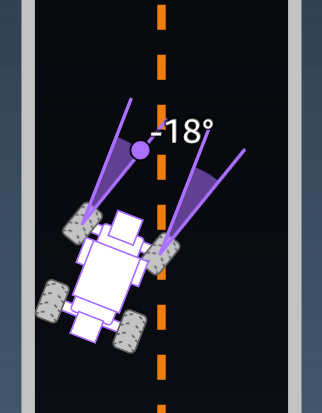
Example:
A reward function using the steering_angle
parameter
def reward_function(params): ''' Example of using steering angle ''' # Read input variable abs_steering = abs(params['steering_angle']) # We don't care whether it is left or right steering # Initialize the reward with typical value reward = 1.0 # Penalize if car steer too much to prevent zigzag ABS_STEERING_THRESHOLD = 20.0 if abs_steering > ABS_STEERING_THRESHOLD: reward *= 0.8 return float(reward)
steps
Type: int
Range: 0:Nstep
Number of steps completed. A step corresponds to an action taken by the agent following the current policy.
Example:
A reward function using the steps
parameter
def reward_function(params): ############################################################################# ''' Example of using steps and progress ''' # Read input variable steps = params['steps'] progress = params['progress'] # Total num of steps we want the car to finish the lap, it will vary depends on the track length TOTAL_NUM_STEPS = 300 # Initialize the reward with typical value reward = 1.0 # Give additional reward if the car pass every 100 steps faster than expected if (steps % 100) == 0 and progress > (steps / TOTAL_NUM_STEPS) * 100 : reward += 10.0 return float(reward)
track_length
Type: float
Range:
[0:Lmax]
The track length in meters. Lmax is track-dependent.
track_width
Type: float
Range: 0:Dtrack
Track width in meters.

Example:
A reward function using the
track_width parameter
def reward_function(params): ############################################################################# ''' Example of using track width ''' # Read input variable track_width = params['track_width'] distance_from_center = params['distance_from_center'] # Calculate the distance from each border distance_from_border = 0.5 * track_width - distance_from_center # Reward higher if the car stays inside the track borders if distance_from_border >= 0.05: reward = 1.0 else: reward = 1e-3 # Low reward if too close to the border or goes off the track return float(reward)
x, y
Type: float
Range: 0:N
Location, in meters, of the agent center along the x and y axes, of the simulated environment containing the track. The origin is at the lower-left corner of the simulated environment.
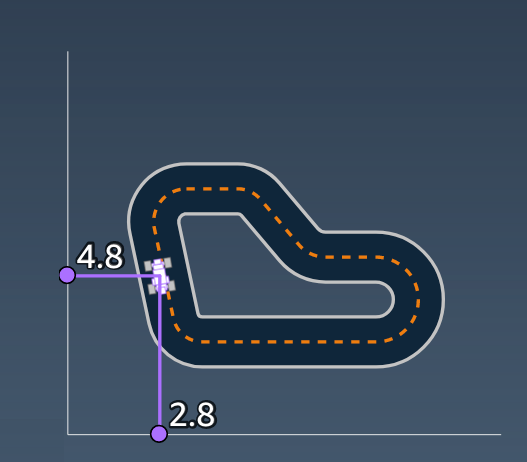
waypoints
Type: list of [float, float]
Range:
[[xw,0,yw,0] …
[xw,Max-1,
yw,Max-1]]
An ordered list of track-dependent Max milestones along the track
center. Each milestone is described by a coordinate of (xw,i,
yw,i). For a looped track, the first and last waypoints
are the same. For a straight or other non-looped track, the first and last waypoints
are different.
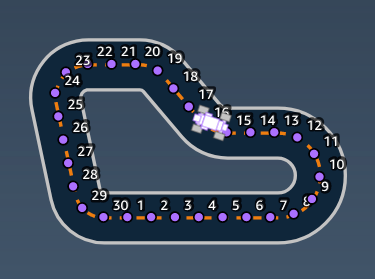
Example
A reward function using the
waypoints parameter
For more information, see closest_waypoints.